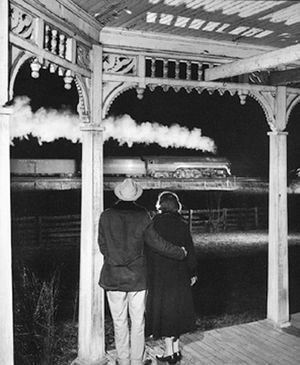Travel: Roanoke’s O. Winston Link Museum Chronicles the End of America’s Steam Engines
(Photo courtesy O. Winston Link Museum, Roanoke, Virginia)
Once you see one of his photographs, you never forget it. Inky darkness is frosted and silvered by pools of light. People and places, most in small towns in rural Virginia, are frozen in the moment. And always, dominating the scene in sometimes startling ways, is the presence of a massive engine, billowing a plume of smoke and steam.
O. Winston Link was born in Brooklyn, New York, 1914 and like most boys of his time, he had a fascination for the big steam engines that roared down the tracks through small towns and big cities across the United States. But it wasn’t until after World War II that he found an outlet for that fascination. While on an industrial photography assignment in Staunton, Virginia, Link traveled to Waynesboro to take photos of the Norfolk & Western Railway steam engines, the only railroad still running steam engines at that time. For the next five years he would spend more than $25,000 of his own money and countless hours photographing the trains and the people who worked and relied on them.
Today, the exhibit at the O. Winston Link Museum in Roanoke, Virginia perfectly illustrates the power of Link’s single-minded devotion to chronicling the last of the giants.
When you see the photos, most taken at night and almost all done in black and white, they at first look like moments of photographic good fortune; being in the right place at the right moment to capture a tableau of ordinary life in the mid-1950s. Light casts strange and eerie shadows on the gigantic engines as well as across the land, houses and people in the photos.
But Link, who studied engineering before going on to become a professional photographer after World War II, and who was a skilled craftsman in his own right, was more than just a man with a camera. Nothing in his photographs was left to chance. He captured larger images by rigging a line of cameras to fire at exactly the same moment and then stitching together the photos.The people were placed, the composition worked out as elaborately as the lighting that illuminated the scene.
"You can't move the sun, and you can't move the tracks, so you have to do something else to better light the engines," Link said. He chose to take his photographs at night and controlled every aspect of the photos. Through his lens and his genius with lighting, wiring dozens of bulbs to fire at exactly the right moment, replacing lanterns in the hands of railroad men even lamps in nearby homes, he conjured exactly what he wanted to see. And, ultimately, what he wanted us to see.
When the last steam engine ran in 1960, Link photographed it from behind a couple standing on the front porch of their home. It was the end of an era and the end of his project.
At the time no one was interested in photos of steam engines. That was yesterday’s technology. Photos, when he could sell one, went for next to nothing. He did better selling high-quality recordings of steam engines and whistles and it wasn’t until the 1980s that Link got the recognition he deserved.
Today, strolling through the O. Winston Link Museum in Roanoke, next to the Virginia Museum of Transportation, studying the images he produced you are drawn into the scene, compelled to look closer for the tiniest details of the composition.
Link painted with light on photographic paper creating stark, indelible, dramatic images of mechanical dinosaurs rolling and belching clouds of steam on their way to extinction. To stand and look at his work is like being taken along on that historic ride.
Cheryl-Anne Millsap is a travel writer based in Spokane, Washington. Her essays can be heard on Spokane Public Radio and on public radio stations across the country. She is the author of “Home Planet: A Life in Four Seasons” and can be reached at catmillsap@gmail.com
